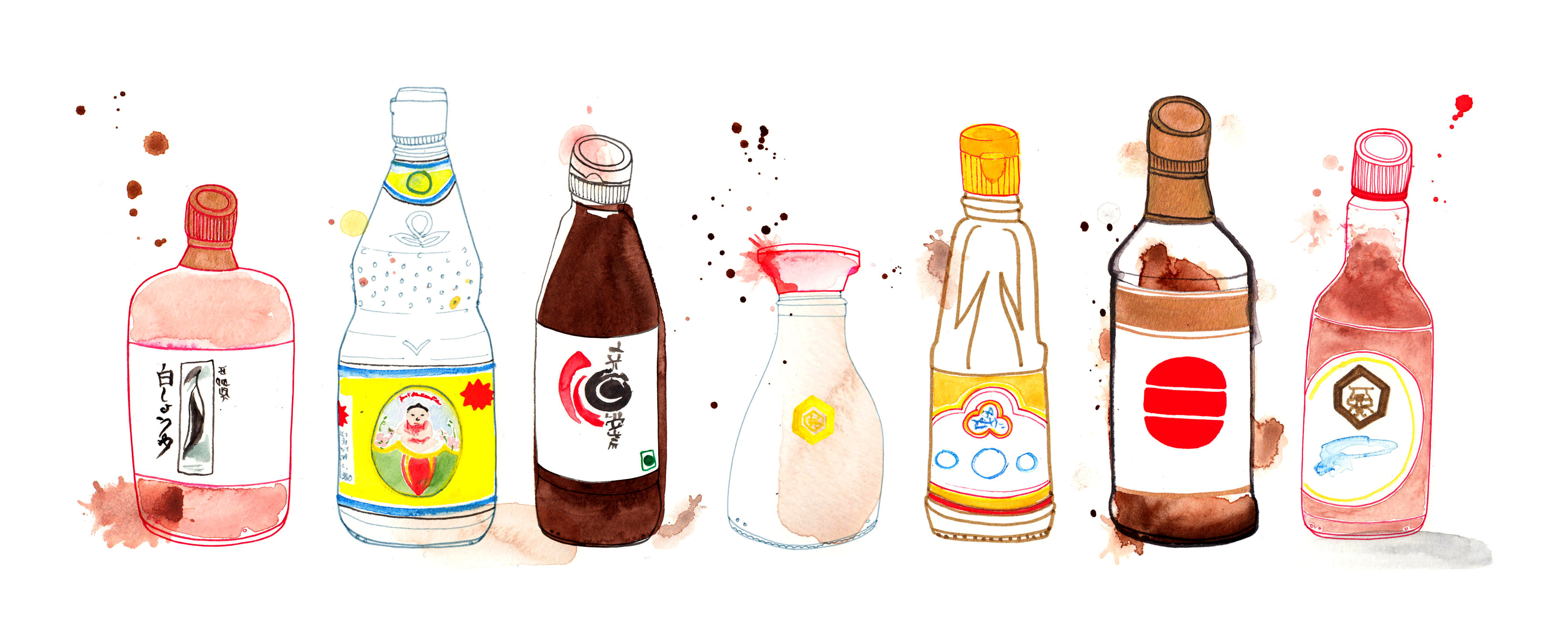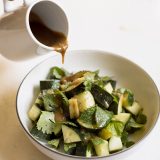In Japan, fried chicken is everywhere. Packaged to grab and go at Tokyo’s underground markets. Doled out at family dinner tables. Served as the antidote for one too many sakes at the izakaya. But it’s not KFC. It’s kaarage, crisp bites of soy- and ginger-spiked chicken.
Karaage (pronounced ka-rah-ah-gay) is always made with dark meat, which is juicier, more flavorful and retains moisture better when deep-fried. The chicken is usually cut into pieces, making it easier to manage with chopsticks and faster to flavor—it takes minutes, not hours, to marinate the meat in a slurry of soy sauce, grated fresh ginger and mirin or sake. And in contrast to the heavily breaded Southern fried chicken most Americans know, karaage is lightly dredged in potato starch. The result is a thin, crisp crust that holds its crunch as the fried chicken sits.
One would peg karaage for a Western-inspired yoshoku recipe, like Japanese potato salad. But it actually owes its origins to China. “Kara” means Chinese—specifically the Tang Dynasty, circa 618-907 C.E.—and “-age” roughly translates to “frying.” A secondary translation is “empty frying,” a reference to the method of frying without the typical tempura batter. And though the chicken itself is often referred to as karaage, the dish is actually just the most popular in a broader category of fried foods—fish, meats, poultry—coated with potato starch. For our Japanese fried chicken, we cut chicken thighs into thirds. We replaced basic soy sauce with tamari, a Japanese-style soy sauce (see below). The tamari is less salty than the average soy sauce, so it gave the marinade more nuance. We liked a gingery marinade, ultimately using a whopping 3 ounces of it—so much, in fact, we swapped out the wand-style grater we typically use for ginger in favor of a more-efficient box grater. We squeezed the ginger juice out of the grated shreds into a mixture of equal parts tamari and sake, then added the pulp for good measure. Breaking with convention, we added finely grated lemon zest, which sharpened the bite of the ginger.
Then came the dredging. While we enjoyed the light, crisp texture the potato starch produced, it proved stubborn to work with—sticky and gluey unless handled with the utmost care. More common cornstarch was far easier to use and produced a similar crust. We added some heat to the coating with black pepper and the Japanese rice seasoning shichimi togarashi, a spicy blend of ground chili flakes, sesame seeds, dried orange zest and seaweed found in the grocery store’s international aisle and at Asian markets (substitute 1 teaspoon of red pepper flakes if you can’t find it). The crust crisped best when we allowed the coated chicken to rest uncovered in the refrigerator for 30 minutes before frying.
The small pieces cooked through in just a few minutes at a relatively high 375°F (that initial temperature will drop when the chicken is added to the pot, then climb back up). We preferred peanut oil for its clean flavor, but any neutral cooking oil with a high enough smoke point will do.
Lemon wedges and a quick dipping sauce made with more grated fresh ginger and tamari, plus sesame oil and thinly sliced scallions, was a perfect match. Forget the sticky-sweet sauces you’ve used before; this one is simple and won’t obscure the chicken’s flavor.
Soy sauce has been around for a millenium. Originally used as a preservative, it was mostly homebrewed until the 16th century. It’s traditionally made with a cultured blend of soybeans, roasted wheat and saltwater. After a lengthy fermentation (typically between four months and a year), the mixture is filtered and pasteurized. Synthetic soy sauces— made from hydrolyzed vegetable protein and hydrochloric acid—can be produced in days or weeks.
Perhaps the best way to subdivide soy sauce varieties is by country of origin. Though the condiment is produced in Vietnam, Korea, Indonesia and beyond, most varieties are from Japan and China. Japanese soy sauce (shoyu) tends to be thinner and less salty than Chinese soy sauce (jiangyou). Japanese brands are also typically made with more wheat, which gives them a sweeter, tangier taste.
Soy sauce is as multifarious as oil and vinegar. Whatever variety you buy, look for those labelled “naturally brewed” or “fermented.” Soybeans, wheat, salt and water should take the lead in the ingredient list. This guide to some of the most common types of soy sauce should help.

- Chinese light soy sauce (sheng chou)
Made from the first pressing of soybeans; saltier and lighter in color in body than lao chou. Won’t discolor food. Most commonly used type of soy sauce in Chinese cuisine; sometimes labelled “superior” or “thin” soy sauce.
- Chinese dark soy sauce (lao chou)
From later pressings; desner, sweeter, darker than sheng chou. Gives braised “red-cooking” dishes their color. Often used in tanem with Chinese light soy sauce to create a balance in color and flavor.
- Japanese dark soy sauce (koikuchi shoyu)
Made with equal parts soy, wheat, salt, and water; deeper color, more balanced flavor and fuller body than usukuchi. Used generously for basting, marinating and simmering food. The default soy sauce in Japanese cooking.
- Japanese light soy sauce (usukuchi shoyu)
Saltier than koikuchi; lighter in color and thinner in body due to the addition of mirin, a sweet rice wine. Usually added to quick-cooking dishes and used sparingly, mostly as seasoning.
- Tamari
Made with little to no wheat; has strong soy flavor as a result. More viscous and darker than other Japanese soy sauces. Used in dipping sauces and for basting. If avoiding gluten, make sure label reads “gluten-free” and check the ingredients.
- White soy sauce (shiro shoyu)
Brewed with mostly wheat, fermented only a few months; light golden in color, faintly sweet, with delicate umami flavor. Often used in dipping sauces and in clear soups.
- Sweet soy sauce (kecap manis)
Flavored with palm sugar, garlic, and spices (star anise, galangal, and ginger); dark, syrupy, sweet. Indonesian in origin. Used liberally for marinating, seasoning noodle dishes and stir-fries, or for dipping sauces.






